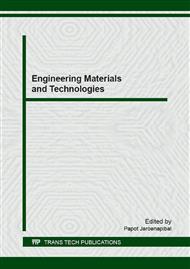p.81
p.87
p.95
p.100
p.105
p.110
p.115
p.120
p.129
Binary Fe and Mn Oxide Nanoparticle Supported Polymeric Anion Exchanger for Arsenic Adsorption: Role of Oxides, Supported Materials, and Preparation Solvent
Abstract:
In this work, binary Fe/Mn oxide nanoparticles were incorporated onto the matrix of anion exchange resin, resulting in hybrid polymeric/inorganic nanoadsorbent named as A502P-Fe/Mn. During synthesis process, effects of various types of metal oxides, preparation solvent, supporting materials, and loading cycles were also investigated. To reduce the charge repulsion force between cationic Fe3+ and Mn4+ ions and fixed-positively charged quaternary amine (R4N+) functional groups of the anion exchange support, mixed solution containing DI/ethanol was introduced to dissolve metal salts during the preparation process. The data obtained by equilibrium batch test indicated that the A502P-Fe/Mn prepared from mixed 50:50 of DI and ethanol exhibited the highest As (V) sorption capacity. The synthesized material was further characterized by using scanning electron microscope (SEM) equipped with energy dispersive X ray spectroscopy (EDX) to verify the existence and distribution of elemental Fe, Mn, and As inside the polymeric beads. Equilibrium As (V) sorption isotherm, effect of solution pH, and point of zero charge of material were also evaluated. This A502P-Fe/Mn can have a promising potential for arsenic removal applications.
Info:
Periodical:
Pages:
105-109
Citation:
Online since:
November 2016
Keywords:
Price:
Сopyright:
© 2017 Trans Tech Publications Ltd. All Rights Reserved
Share:
Citation:


